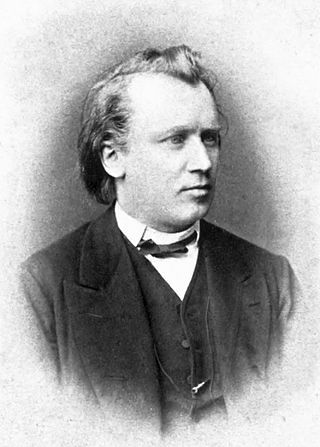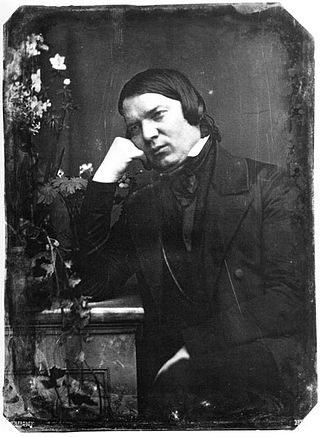
Johannes Brahms was a German composer, pianist, and conductor of the mid-Romantic period. Born in Hamburg into a Lutheran family, he spent much of his professional life in Vienna. He is sometimes grouped with Johann Sebastian Bach and Ludwig van Beethoven as one of the "Three Bs" of music, a comment originally made by the nineteenth-century conductor Hans von Bülow.

Robert Schumann was a German composer, pianist, and music critic of the early Romantic era. He composed in all the main musical genres of the time, writing for solo piano, voice and piano, chamber groups, orchestra, choir and the opera. His works typified the spirit of the Romantic era in German music.

Clara Josephine Schumann was a German pianist, composer, and piano teacher. Regarded as one of the most distinguished pianists of the Romantic era, she exerted her influence over the course of a 61-year concert career, changing the format and repertoire of the piano recital by lessening the importance of purely virtuosic works. She also composed solo piano pieces, a piano concerto, chamber music, choral pieces, and songs.

The Piano Concerto in A minor, Op. 54, by the German Romantic composer Robert Schumann was completed in 1845 and is the composer's only piano concerto. The complete work was premiered in Dresden on 4 December 1845. It is one of the most widely performed and recorded piano concertos from the Romantic period.

The Piano Quintet in E-flat major, Op. 44, by Robert Schumann was composed in 1842 and received its first public performance the following year. Noted for its "extroverted, exuberant" character, Schumann's piano quintet is considered one of his finest compositions and a major work of nineteenth-century chamber music. Composed for piano and string quartet, the work revolutionized the instrumentation and musical character of the piano quintet and established it as a quintessentially Romantic genre.

Carnaval, Op. 9, is a work by Robert Schumann for piano solo, written in 1834–1835 and subtitled Scènes mignonnes sur quatre notes. It consists of 21 short pieces representing masked revelers at Carnival, a festival before Lent. Schumann gives musical expression to himself, his friends and colleagues, and characters from improvised Italian comedy. He dedicated the work to the violinist Karol Lipiński.

Kreisleriana, Op. 16, is a composition in eight movements by Robert Schumann for solo piano, subtitled Phantasien für das Pianoforte. Schumann claimed to have written it in only four days in April 1838 and a revised version appeared in 1850. The work was dedicated to Frédéric Chopin, but when a copy was sent to the Polish composer, "he commented favorably only on the design of the title page".

The Symphonic Studies, Op. 13, is a set of études for solo piano by Robert Schumann. It began in 1834 as a theme and sixteen variations on a theme by Baron von Fricken, plus a further variation on an entirely different theme by Heinrich Marschner.

Davidsbündlertänze, Op. 6, is a group of eighteen pieces for piano composed in 1837 by Robert Schumann, who named them after his music society Davidsbündler. The low opus number is misleading: the work was written after Carnaval, Op. 9, and the Symphonic Studies, Op. 13.
The Ballade No. 2 in F major, Op. 38 is a ballade for solo piano by Frédéric Chopin, completed in 1839. A typical performance lasts six to eight minutes.

Johannes Brahms composed his Piano Trio No. 2 in C Major, Op. 87, between 1880 and 1882. It is scored for piano, violin and cello. He wrote this piece at the age of 49.

The Piano Quartet No. 3 in C minor, Op. 60, completed by Johannes Brahms in 1875, is scored for piano, violin, viola and cello. It is sometimes called the Werther Quartet after Goethe's The Sorrows of Young Werther. The premiere took place in Vienna on November 18, 1875, to an anxious public. Richard Wagner and his wife Cosima were in attendance.
Blumenstück in D-flat, Op. 19, is a piano work by Robert Schumann, written in 1839. Blumenstück is a series of short, connected and thematically related episodes, of which the second forms a recurring refrain while undergoing changes in both key and mood. It is considered to reflect the amorous human activities with which flowers are associated, rather than as depictions of flowers themselves. The piece takes between six and seven minutes to play.

Frédéric Chopin's Variations on "Là ci darem la mano" for piano and orchestra, Op. 2, was written in 1827, when he was aged 17. "Là ci darem la mano" is a duet sung by Don Giovanni and Zerlina in act 1 of Mozart's 1787 opera Don Giovanni. In a manuscript of this composition, dedicated to his schoolfriend Tytus Woyciechowski, the latter replied on the title page in written form „J’accepte avec plaisir“. Chopin's work inspired Robert Schumann's famous exclamation: "Hats off, gentlemen, a genius." The work is often recorded and played in concert. A typical performance lasts from 17 to 19 minutes. One autograph of the version for solo piano is held by the Austrian National Library.

The Piano Quartet in E♭ major, Op. 47, was composed by Robert Schumann in 1842 for piano, violin, viola and cello. Written during a productive period in which he produced several large-scale chamber music works, it has been described as the "creative double" of his Piano Quintet, finished weeks earlier. Though dedicated to the Russian cellist Mathieu Wielhorsky, it was written with Schumann's wife Clara in mind, who would be the pianist at the premiere on 8 December 1844 in Leipzig.
Composed in 1846, the Piano Trio in G minor, opus 17 by Clara Schumann is considered her greatest, most mature four-movement work. It is her only piano trio, composed while she lived in Dresden, following extensive studies in fugue writing and the publication of her Three Preludes and Fugues For Piano, opus 16 in 1845. The trio was premiered by the composer in Vienna on January 15th, 1847.
4 Pièces caractéristiques by Clara Schumann was composed between 1834 and 1836, and published in 1836. The entire work is labeled as opus 5, and is written for solo piano. The pieces are as follows.

The Three Romances for Oboe and Piano, Op. 94 is a composition by Robert Schumann, his only composition for oboe. It was composed in December 1849. The work consists of three short pieces in A-B-A form, and it was written during what was speculated to be one of Schumann's manic episodes.
Bunte Blätter, Op. 99, is a collection of piano pieces by Robert Schumann assembled from earlier unpublished pieces after the success of the Album for the Young , Op. 68. Upon publication the pieces were issued both as a complete set and individual pieces, the latter in differently colored covers.

The Abegg Trio was a German piano trio. Since its foundation in 1976, it played in the original line-up.













